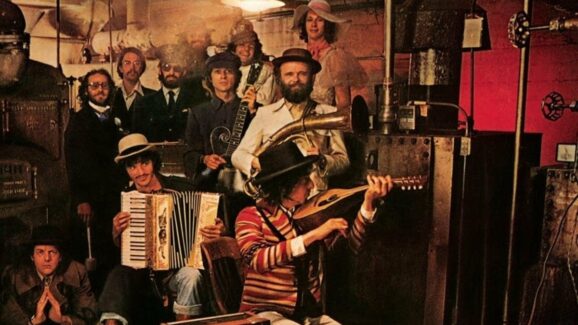Is Buffalo Springfield the most underrated super-group in the history of contemporary rock? That’s a question worth asking now that we have more than a half-century of hindsight since the release of the group’s eponymous debut (released 12/5/66) album in its original form. The subsequent fame of the three principal songwriters, Neil Young, Richie Furay and Stephen Stills, dwarfed the success of their early alliance, to the point that even the best-known song of the band, “For What It’s Worth,” is more often than not directly referenced to its author, the latter-named of the above triad.
Inspired by riots on Los Angeles Sunset Strip, this most acute synopsis of conflict remains relevant today, timelessly so in fact. The Springfield was actually in the process of recording it the very day their first LP came out: released shortly thereafter in late December of 1966, its relative success—it rose to #7 on the Billboard charts—prompted Atco Records to reissue the long-player in modified form in February of 1967, for the sake of the ‘hit’ deleting Stills’ “Baby Don’t Scold Me” (and thus relegating to a piece of trivia the guitar quote of the Beatles’ “Day Tripper” riff near its mid-point).
Yet that move was to no avail despite concerted promotion with high-profile (at the time) television appearances on the likes of Hollywood Palace. Readily available for viewing on YouTube, it’s worth noting the composer is front and center as he sings, adorned with the cowboy hat that finds its corollary in the fringed leather jacket Young wears in the background (while bassist Bruce Palmer sits with his back to the camera in front of them both).
The demo recordings that appear on the four-CD self-titled box set of 2001 reveal what a wealth of superior material Buffalo Springfield had to work with when they started out. Full-formed hybrids of folk, country and rock like “Go And Say Goodbye” appear in pristine form next to the moody likes of “Flying On The Ground Is Wrong” and while both benefit from backing from the full band on the album—especially by dint of effortless vocal harmonies—the sonic muddle obscured the chemistry of the five piece ensemble including drummer Dewey Martin and his aforementioned partner in the rhythm section.
Overseen by Young and his technical team, the remastering completed for the 2018 collection, What’s that Sound?, improves the sound quality of Buffalo Springfield at least somewhat. Following in the footsteps of the 1997 release (overseen by Neil Young) including both mono and stereo mixes on a single CD, it also offers the choice of hearing both versions of the album, with thirteen tracks in mono, in addition to its abridged stereo counterpart; the improved depth of Stills’ anthem is immediately noticeable wherever it appears, while the two-channel sound reveals just how dense these recordings are.
Yet even the paper-thin mix elsewhere can’t obscure the versatility at work on Buffalo Springfield over the course of its thirty-plus minutes playing time (eight of which tracks are less than three minutes in duration). Not only did the group have three markedly distinct vocalists in Young (“Out Of My Mind”), Stills (“Hot Dusty Roads”) and Furay (“Do I Have to Come Right Out and Say It”), but the first two men were each well-defined, excellent lead guitarists, the former specializing in warm, fluid tones (“Nowadays Clancy Can’t Even Sing”), the latter an expert in more staccato touch (“Leave”).
In the midst of all these positive attributes, emotional honesty and mastery of craft are most prominent, the mesh of which virtues is seamless as that of the acoustic and electric guitars. This is a work of remarkable sophistication on its own terms, but especially so for such a young unit: it is that ever-so-rare instance of individual artists hitting their respective peaks simultaneously within the confines of a group.
By the time the sophomore Buffalo Springfield effort was in the works, however, Furay, Young and Stills had each revealed themselves to be strong composers and singers. And the latter two, after chomping at the bit during the recording of the first album produced by fledgling managers and studio novices, Charles Greene and Brian Stone, quickly became independently creative, technically as well as instrumentally. Notwithstanding that growth, by the time Again was released in late 1967, fractures grew within the group who played their final gig in May of 1968.
Their final studio album, Last Time Around, came out two months later, consisting of recordings assembled by Furay with replacement bassist Jim Messina. The two so closely bonded during their collaboration, they went on to form the seminal country-rock band Poco. Around that same time, Stills was in the early stages of working with Crosby and Nash (the first fruits of which would appear the next year), while Neil began solo performances such as those captured on Sugar Mountain– Live at Canterbury House 1968. Various mottled reunions of the group have taken place over the years, the one of 2011 carrying the most validity, but that initiative came to something of an abrupt halt.
With fifty-five years retrospect, it’s fair to say that if Buffalo Springfield suffered from anything other than an egregious lack of recognition, it was an abundance of talent. Yet even as so poorly represented on their very first LP, the precocious confluence of skills ranks with the greatest work of its mid-to-late Sixties era.












